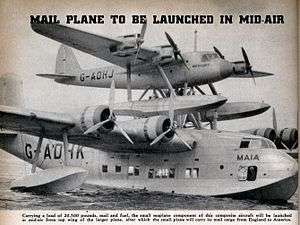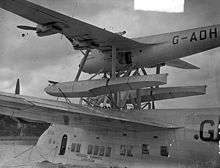Short Mayo Composite
| S.20 Mercury | |
|---|---|
 | |
| Image from a contemporary newspaper article, depicting Mercury atop Maia | |
| Role | Transport seaplane carried to flight altitude by Short S.21 Maia |
| National origin | United Kingdom |
| Manufacturer | Short Brothers |
| Designer | Arthur Gouge Robert H. Mayo |
| First flight | 5 September 1937 |
| Introduction | 14 July 1938 |
| Retired | 1941 |
| Primary users | Imperial Airways RAF |
| Number built | 1 |
|
| |
| S.21 Maia | |
|---|---|
| Role | Flying-boat, launch aircraft for S.20 Mercury |
| National origin | United Kingdom |
| Manufacturer | Short Brothers |
| Designer | Arthur Gouge Robert H. Mayo |
| First flight | 27 July 1937 |
| Introduction | 14 July 1938 |
| Status | destroyed by enemy bombing 11 May 1941 |
| Primary user | Imperial Airways |
| Number built | 1 |
|
| |
The Short Mayo Composite was a piggy-back long-range seaplane/flying boat combination produced by Short Brothers to provide a reliable long-range air transport service to the United States and the far reaches of the British Empire and the Commonwealth.
Development
Short Brothers had built the Empire flying boats which were capable of operating long range routes across the British Empire but could only attempt the trans-Atlantic route by replacing passenger and mail-carrying space with extra fuel.
It was known that aircraft could maintain flight with a greater load than is possible to take off with; Major Robert H. Mayo, Technical General Manager at Imperial Airways proposed mounting a small, long-range seaplane on top of a larger carrier aircraft, using the combined power of both to bring the smaller aircraft to operational height, at which time the two aircraft would separate, the carrier aircraft returning to base while the other flew on to its destination. The British Air Ministry issued Specification "13/33" to cover this project.
Design
The Short-Mayo composite project, co-designed by Mayo and Shorts chief designer Arthur Gouge,[1][2] comprised the Short S.21 Maia,[3] (G-ADHK) which was a variant of the Short "C-Class" Empire flying-boat fitted with a trestle or pylon on the top of the fuselage to support the Short S.20 Mercury(G-ADHJ).[3][4]
Although generally similar to the Empire boat, Maia differed considerably in detail: the hull sides were flared and had "tumblehome" rather than being vertical as on the Empire to increase the planing surface (necessary for the higher takeoff weights); larger control surfaces; an increase in total wing area from 1,500 sq ft (140 m2) to 1,750 sq ft (163 m2); the engines were mounted further from the wing root to clear Mercury's floats and the rear fuselage was swept up to raise the tailplane relative to the wing. Like the Empire boats, Maia could be equipped to carry 18 passengers.[1] Maia first flew (without Mercury) on 27 July 1937, piloted by Shorts' Chief Test Pilot, John Lankester Parker.[5]
The upper component, Mercury, was a twin-float, four-engine seaplane crewed by a single pilot and a navigator, who sat in tandem in an enclosed cockpit. It could carry 1,000 lb (456 kg) of mail and 1200 Imperial gallons of fuel. Flight controls, except for elevator and rudder trim tabs, were locked in neutral until separation. Mercury's first flight, also piloted by Parker, was on 5 September 1937.[6]
The mechanism that held the two aircraft together allowed for a small degree of movement. Lights indicated when the upper component was in fore-aft balance so trim could be adjusted prior to release. The pilots could then release their respective locks. At this point the two aircraft remained held together by a third lock which released automatically at 3,000 lb. The design was such that at separation Maia would tend to drop while Mercury would climb.[7]
Operations
.jpg)
The first successful in-flight separation was carried out from the Shorts works at Borstal, near Rochester, Medway, on 6 February 1938, Maia piloted by Parker and Mercury by Harold Piper. Following further successful tests, the first transatlantic flight was made on 21 July 1938 from Foynes, on the west coast of Ireland, to Boucherville,[8] near Montreal, Quebec, Canada, a flight of 2,930 miles (4,714.4 km). Maia, flown by Captain A.S. Wilcockson, took off from Southampton carrying Mercury piloted by Captain Don Bennett.[9] As well as Mercury, the launch aircraft Maia was also carrying 10 passengers and luggage.[10] Mercury separated from her carrier at 8 pm to continue what was to become the first commercial[note 1] non-stop East-to-West transatlantic flight by a heavier-than-air machine. This initial journey took 20 hrs 21 min at an average ground speed of 144 mph (232 km/h).[11]

The Maia-Mercury composite continued in use with Imperial Airways, including Mercury flying to Alexandria, Egypt, in December 1938. After modifications to extend Mercury's range, it subsequently established a record flight for a seaplane of 6,045 miles (9,726.4 km) from Dundee in Scotland to Alexander Bay, in South Africa between 6 and 8 October 1938.
Only one example of the Short-Mayo composite was built, the S.21 Maia with the registration G-ADHK and the S.20 Mercury G-ADHJ. The development of a more powerful and longer-range Empire boat (the Short S.26), the increase in allowable all up weights with the standard "C-Class", the further development of in-flight refuelling and the outbreak of the Second World War combined to render the approach obsolete. Maia was destroyed in Poole Harbour by German bombers on 11 May 1941.[12] Mercury was flown to Felixstowe for use by 320 (Netherlands) Squadron RAF a Dutch seaplane reconnaissance unit serving with the Royal Air Force at RAF Pembroke Dock. When this squadron was re-equipped with Lockheed Hudsons, Mercury was returned to Shorts at Rochester on 9 August 1941 and broken up so that its aluminium could be recycled for use in the war effort.[13]
Operators
Specifications (S.20 Mercury)
Data from Barnes & James 1989 p.312
General characteristics
- Crew: 2 (pilot and navigator/radio operator)
- Payload: 1,000 lb (454 kg)
- Length: 51 ft (15.5)
- Wingspan: 73 ft (22.3 m)
- Height: 20 ft 3 in [14] (6.17 m)
- Wing area: 611 ft² (56.8 m²)
- Empty weight: 10,163 lb (4,610 kg)
- Loaded weight: 26,800 lb (12,156 kg)
- Max. takeoff weight: 15,500 lb (7,030 kg)
- Powerplant: 4 × Napier Rapier VI 16-cylinder "H-block" piston engines, 365 hp (272.29 kW) each
- * Normal composite launch weight: 20,800 lb (9,435 kg)
- Record composite launch weight: 26,800 lb (12,156 kg)
Performance
- Maximum speed: 212 mph (341 km/h)
- Cruise speed: 195 mph (314 km/h)
- Range: 3,900 mi (6,275 km)
- Wing loading: 33.6 lb/sq ft[7] ()
- Extended range: 6,100 mi (9,815 km) (Cape flight)
Specifications (S.21 Maia)
Data from Barnes & James 1989 p.312
General characteristics
- Crew: 3
- Capacity: 18
- Length: 84 ft 11 in (25.9 m)
- Wingspan: 114 ft (34.7 m)
- Height: 32 ft 7½ in[14] (9.94 m)
- Wing area: 1,750 ft2 (162.6 m2)
- Empty weight: 24,745 lb (11,224 kg)
- Loaded weight: 38,000 lb (17,237 kg)
- Powerplant: 4 × Bristol Pegasus XC radial engine, 919 hp (686 kW) each
- *Takeoff weight (composite): 27,700 lb (12,564 kg)
Performance
- Maximum speed: 200 mph (322 km/h)
- Range: 850 mi (1,368 km)
- Service ceiling: 20,000 ft (6,100 m)
In popular culture
- The children's novel The Sound of Propellors by Clive King follows the adventure of an Indian schoolboy who stows away on a fictional test flight from England to India, which is sabotaged by a German spy.
See also
- Related development
- Related lists
Notes
- Notes
- ↑ The British flying boats Caledonia and Cambria had made several non-stop survey flights of the Atlantic route already
- Citations
- 1 2 Barnes C.H. Shorts Aircraft since 1900. London (1989): Putnam. p. 560. ISBN 0-85177-819-4.
- ↑ "World News: Sir Arthur Gouge". Flight International, 25 October 1962, page 660
- 1 2 Named for Maia, the Greek goddess and mother of Hermes, messenger of the Gods, while Hermes was known to the Romans as Mercury
- ↑ Flight 19 August 1937 p180
- ↑ J Lankester Parker OBE FRAeS Hon MSLAE started as a test pilot at Shorts in 1916, was Chief Test Pilot 1918 - 1945 and from 1943 a Director of Short Brothers and Harland, Belfast
- ↑ Jackson 1974, p. 302
- 1 2 Flight 17 February 1938
- ↑ Also contains an eye-witness account of the first in-flight separation
- ↑ Captain Bennett was later the first commander of the RAF Pathfinder Force in WWII and became an Air Vice Marshal
- ↑ "Mercury makes good" p80
- ↑ "Mercury makes good" Flight July 28, 1938. pp79-80
- ↑ Cassidy, Brian (2004). Flying Empires - Short ‘C’ class Empire flying boats. Queens Parade Press. p. 58. ISBN 0-9529298-2-1.
- ↑ Barnes and James, p.311
- 1 2 Angelucci 1984, p.226.
References
- Jackson, A.J. (1974). British Civil Aircraft since 1919 Volume 3. London: Putnam. ISBN 0-370-10014-X.
- Angelucci, Enzo (1984). World Encyclopedia of Civil Aircraft. London: Willow Books. ISBN 0-00-218148-7.
- Composite Aircraft Flight 1935
- The Great Experiment Flight 1937
- "Short Mayo - The Composite Aircraft Described in Detail" (PDF). Flight Magazine (Reed Business Information Ltd.). XXXIII (1521): (Supplement at p.159.). 17 Feb 1938. Retrieved 7 July 2011.
External links
| Wikimedia Commons has media related to Short Mayo Composite. |
|
|
- 1935 article describing the proposed Short-Mayo Composite
- "Flying Boat Launches Sea Mail Plane in Air" Popular Mechanics, April 1935, article with drawing explaining concept of purposed Short Mayo Composition.
- Aero Stories
- Contemporary article in Time magazine, 14 February 1938
- Irish Inland Waterway News, Winter 2001
- Imperial Airways history
- Image of the Maia/Mercury at www.historyofaircargo.com
- Download link for "The Guild of Aircraft Pilots and Navigators of London 1929 - 2004"
- Winchester, Clarence, ed. (1938), "The Short-Mayo aircraft", Wonders of World Aviation, pp. 25–29
|
|